Hao Yuan
LimiX: Unleashing Structured-Data Modeling Capability for Generalist Intelligence
Sep 03, 2025Abstract:We argue that progress toward general intelligence requires complementary foundation models grounded in language, the physical world, and structured data. This report presents LimiX, the first installment of our large structured-data models (LDMs). LimiX treats structured data as a joint distribution over variables and missingness, thus capable of addressing a wide range of tabular tasks through query-based conditional prediction via a single model. LimiX is pretrained using masked joint-distribution modeling with an episodic, context-conditional objective, where the model predicts for query subsets conditioned on dataset-specific contexts, supporting rapid, training-free adaptation at inference. We evaluate LimiX across 10 large structured-data benchmarks with broad regimes of sample size, feature dimensionality, class number, categorical-to-numerical feature ratio, missingness, and sample-to-feature ratios. With a single model and a unified interface, LimiX consistently surpasses strong baselines including gradient-boosting trees, deep tabular networks, recent tabular foundation models, and automated ensembles, as shown in Figure 1 and Figure 2. The superiority holds across a wide range of tasks, such as classification, regression, missing value imputation, and data generation, often by substantial margins, while avoiding task-specific architectures or bespoke training per task. All LimiX models are publicly accessible under Apache 2.0.
Aug2Search: Enhancing Facebook Marketplace Search with LLM-Generated Synthetic Data Augmentation
May 21, 2025Abstract:Embedding-Based Retrieval (EBR) is an important technique in modern search engines, enabling semantic match between search queries and relevant results. However, search logging data on platforms like Facebook Marketplace lacks the diversity and details needed for effective EBR model training, limiting the models' ability to capture nuanced search patterns. To address this challenge, we propose Aug2Search, an EBR-based framework leveraging synthetic data generated by Generative AI (GenAI) models, in a multimodal and multitask approach to optimize query-product relevance. This paper investigates the capabilities of GenAI, particularly Large Language Models (LLMs), in generating high-quality synthetic data, and analyzing its impact on enhancing EBR models. We conducted experiments using eight Llama models and 100 million data points from Facebook Marketplace logs. Our synthetic data generation follows three strategies: (1) generate queries, (2) enhance product listings, and (3) generate queries from enhanced listings. We train EBR models on three different datasets: sampled engagement data or original data ((e.g., "Click" and "Listing Interactions")), synthetic data, and a mixture of both engagement and synthetic data to assess their performance across various training sets. Our findings underscore the robustness of Llama models in producing synthetic queries and listings with high coherence, relevance, and diversity, while maintaining low levels of hallucination. Aug2Search achieves an improvement of up to 4% in ROC_AUC with 100 million synthetic data samples, demonstrating the effectiveness of our approach. Moreover, our experiments reveal that with the same volume of training data, models trained exclusively on synthetic data often outperform those trained on original data only or a mixture of original and synthetic data.
Cross-Organ Domain Adaptive Neural Network for Pancreatic Endoscopic Ultrasound Image Segmentation
Sep 07, 2024Abstract:Accurate segmentation of lesions in pancreatic endoscopic ultrasound (EUS) images is crucial for effective diagnosis and treatment. However, the collection of enough crisp EUS images for effective diagnosis is arduous. Recently, domain adaptation (DA) has been employed to address these challenges by leveraging related knowledge from other domains. Most DA methods only focus on multi-view representations of the same organ, which makes it still tough to clearly depict the tumor lesion area with limited semantic information. Although transferring homogeneous similarity from different organs could benefit the issue, there is a lack of relevant work due to the enormous domain gap between them. To address these challenges, we propose the Cross-Organ Tumor Segmentation Networks (COTS-Nets), consisting of a universal network and an auxiliary network. The universal network utilizes boundary loss to learn common boundary information of different tumors, enabling accurate delineation of tumors in EUS despite limited and low-quality data. Simultaneously, we incorporate consistency loss in the universal network to align the prediction of pancreatic EUS with tumor boundaries from other organs to mitigate the domain gap. To further reduce the cross-organ domain gap, the auxiliary network integrates multi-scale features from different organs, aiding the universal network in acquiring domain-invariant knowledge. Systematic experiments demonstrate that COTS-Nets significantly improves the accuracy of pancreatic cancer diagnosis. Additionally, we developed the Pancreatic Cancer Endoscopic Ultrasound (PCEUS) dataset, comprising 501 pathologically confirmed pancreatic EUS images, to facilitate model development.
KwaiAgents: Generalized Information-seeking Agent System with Large Language Models
Dec 08, 2023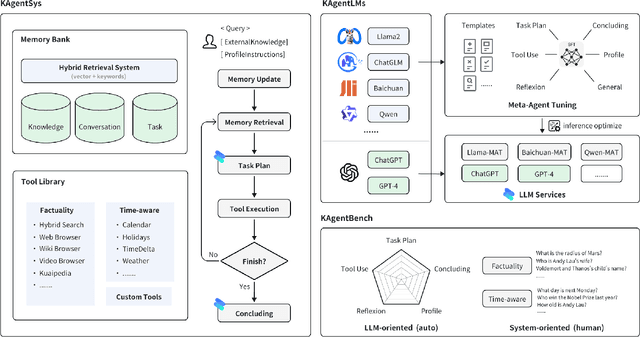

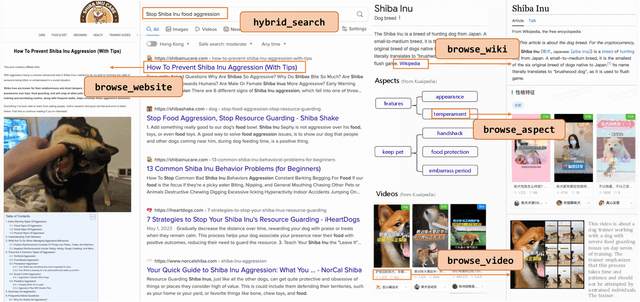

Abstract:Driven by curiosity, humans have continually sought to explore and understand the world around them, leading to the invention of various tools to satiate this inquisitiveness. Despite not having the capacity to process and memorize vast amounts of information in their brains, humans excel in critical thinking, planning, reflection, and harnessing available tools to interact with and interpret the world, enabling them to find answers efficiently. The recent advancements in large language models (LLMs) suggest that machines might also possess the aforementioned human-like capabilities, allowing them to exhibit powerful abilities even with a constrained parameter count. In this paper, we introduce KwaiAgents, a generalized information-seeking agent system based on LLMs. Within KwaiAgents, we propose an agent system that employs LLMs as its cognitive core, which is capable of understanding a user's query, behavior guidelines, and referencing external documents. The agent can also update and retrieve information from its internal memory, plan and execute actions using a time-aware search-browse toolkit, and ultimately provide a comprehensive response. We further investigate the system's performance when powered by LLMs less advanced than GPT-4, and introduce the Meta-Agent Tuning (MAT) framework, designed to ensure even an open-sourced 7B or 13B model performs well among many agent systems. We exploit both benchmark and human evaluations to systematically validate these capabilities. Extensive experiments show the superiority of our agent system compared to other autonomous agents and highlight the enhanced generalized agent-abilities of our fine-tuned LLMs.
NeutronOrch: Rethinking Sample-based GNN Training under CPU-GPU Heterogeneous Environments
Nov 22, 2023Abstract:Graph Neural Networks (GNNs) have demonstrated outstanding performance in various applications. Existing frameworks utilize CPU-GPU heterogeneous environments to train GNN models and integrate mini-batch and sampling techniques to overcome the GPU memory limitation. In CPU-GPU heterogeneous environments, we can divide sample-based GNN training into three steps: sample, gather, and train. Existing GNN systems use different task orchestrating methods to employ each step on CPU or GPU. After extensive experiments and analysis, we find that existing task orchestrating methods fail to fully utilize the heterogeneous resources, limited by inefficient CPU processing or GPU resource contention. In this paper, we propose NeutronOrch, a system for sample-based GNN training that incorporates a layer-based task orchestrating method and ensures balanced utilization of the CPU and GPU. NeutronOrch decouples the training process by layer and pushes down the training task of the bottom layer to the CPU. This significantly reduces the computational load and memory footprint of GPU training. To avoid inefficient CPU processing, NeutronOrch only offloads the training of frequently accessed vertices to the CPU and lets GPU reuse their embeddings with bounded staleness. Furthermore, NeutronOrch provides a fine-grained pipeline design for the layer-based task orchestrating method, fully overlapping different tasks on heterogeneous resources while strictly guaranteeing bounded staleness. The experimental results show that compared with the state-of-the-art GNN systems, NeutronOrch can achieve up to 4.61x performance speedup.
Comprehensive Evaluation of GNN Training Systems: A Data Management Perspective
Nov 22, 2023Abstract:Many Graph Neural Network (GNN) training systems have emerged recently to support efficient GNN training. Since GNNs embody complex data dependencies between training samples, the training of GNNs should address distinct challenges different from DNN training in data management, such as data partitioning, batch preparation for mini-batch training, and data transferring between CPUs and GPUs. These factors, which take up a large proportion of training time, make data management in GNN training more significant. This paper reviews GNN training from a data management perspective and provides a comprehensive analysis and evaluation of the representative approaches. We conduct extensive experiments on various benchmark datasets and show many interesting and valuable results. We also provide some practical tips learned from these experiments, which are helpful for designing GNN training systems in the future.
A Simple Temporal Information Matching Mechanism for Entity Alignment Between Temporal Knowledge Graphs
Sep 20, 2022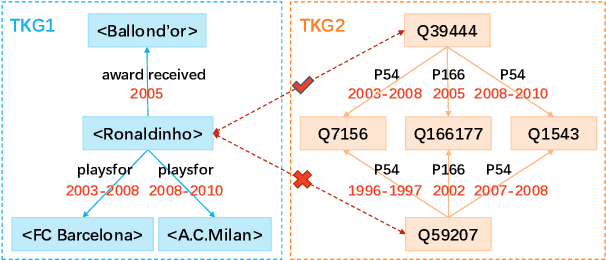

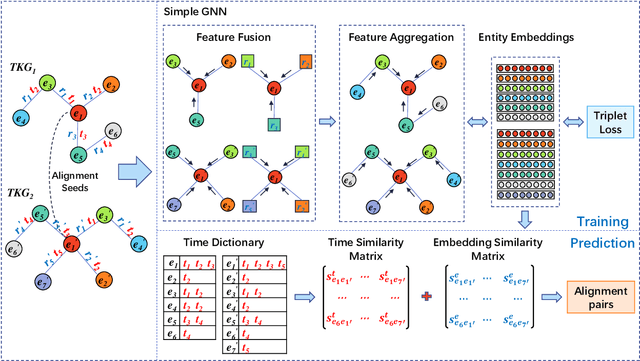
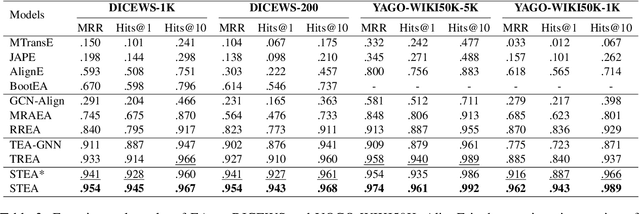
Abstract:Entity alignment (EA) aims to find entities in different knowledge graphs (KGs) that refer to the same object in the real world. Recent studies incorporate temporal information to augment the representations of KGs. The existing methods for EA between temporal KGs (TKGs) utilize a time-aware attention mechanism to incorporate relational and temporal information into entity embeddings. The approaches outperform the previous methods by using temporal information. However, we believe that it is not necessary to learn the embeddings of temporal information in KGs since most TKGs have uniform temporal representations. Therefore, we propose a simple graph neural network (GNN) model combined with a temporal information matching mechanism, which achieves better performance with less time and fewer parameters. Furthermore, since alignment seeds are difficult to label in real-world applications, we also propose a method to generate unsupervised alignment seeds via the temporal information of TKG. Extensive experiments on public datasets indicate that our supervised method significantly outperforms the previous methods and the unsupervised one has competitive performance.
FlowX: Towards Explainable Graph Neural Networks via Message Flows
Jun 26, 2022



Abstract:We investigate the explainability of graph neural networks (GNNs) as a step towards elucidating their working mechanisms. While most current methods focus on explaining graph nodes, edges, or features, we argue that, as the inherent functional mechanism of GNNs, message flows are more natural for performing explainability. To this end, we propose a novel method here, known as FlowX, to explain GNNs by identifying important message flows. To quantify the importance of flows, we propose to follow the philosophy of Shapley values from cooperative game theory. To tackle the complexity of computing all coalitions' marginal contributions, we propose an approximation scheme to compute Shapley-like values as initial assessments of further redistribution training. We then propose a learning algorithm to train flow scores and improve explainability. Experimental studies on both synthetic and real-world datasets demonstrate that our proposed FlowX leads to improved explainability of GNNs.
A Dual-Attention Neural Network for Pun Location and Using Pun-Gloss Pairs for Interpretation
Oct 14, 2021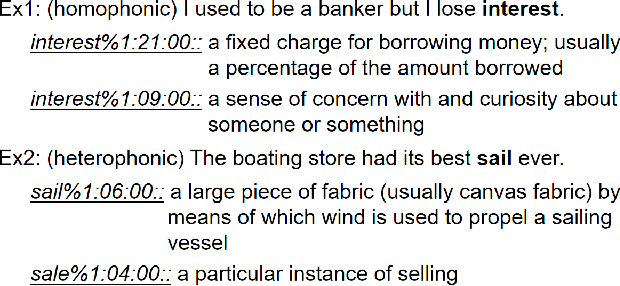

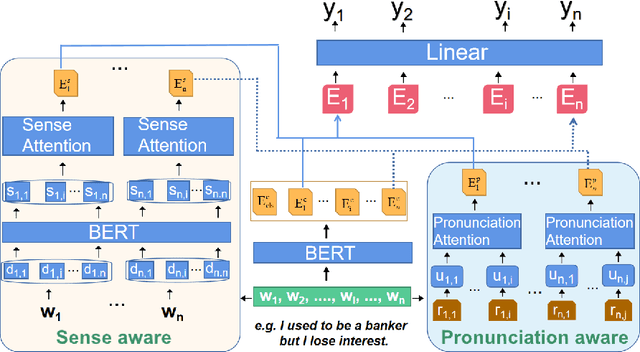
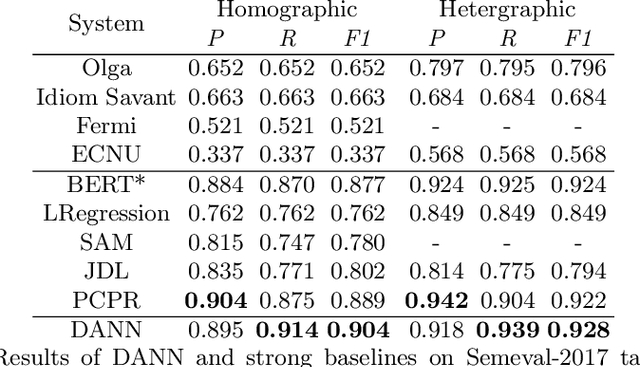
Abstract:Pun location is to identify the punning word (usually a word or a phrase that makes the text ambiguous) in a given short text, and pun interpretation is to find out two different meanings of the punning word. Most previous studies adopt limited word senses obtained by WSD(Word Sense Disambiguation) technique or pronunciation information in isolation to address pun location. For the task of pun interpretation, related work pays attention to various WSD algorithms. In this paper, a model called DANN (Dual-Attentive Neural Network) is proposed for pun location, effectively integrates word senses and pronunciation with context information to address two kinds of pun at the same time. Furthermore, we treat pun interpretation as a classification task and construct pungloss pairs as processing data to solve this task. Experiments on the two benchmark datasets show that our proposed methods achieve new state-of-the-art results. Our source code is available in the public code repository.
Fast Quantum Property Prediction via Deeper 2D and 3D Graph Networks
Jun 16, 2021



Abstract:Molecular property prediction is gaining increasing attention due to its diverse applications. One task of particular interests and importance is to predict quantum chemical properties without 3D equilibrium structures. This is practically favorable since obtaining 3D equilibrium structures requires extremely expensive calculations. In this work, we design a deep graph neural network to predict quantum properties by directly learning from 2D molecular graphs. In addition, we propose a 3D graph neural network to learn from low-cost conformer sets, which can be obtained with open-source tools using an affordable budget. We employ our methods to participate in the 2021 KDD Cup on OGB Large-Scale Challenge (OGB-LSC), which aims to predict the HOMO-LUMO energy gap of molecules. Final evaluation results reveal that we are one of the winners with a mean absolute error of 0.1235 on the holdout test set. Our implementation is available as part of the MoleculeX package (https://github.com/divelab/MoleculeX).
 Add to Chrome
Add to Chrome Add to Firefox
Add to Firefox Add to Edge
Add to Edge